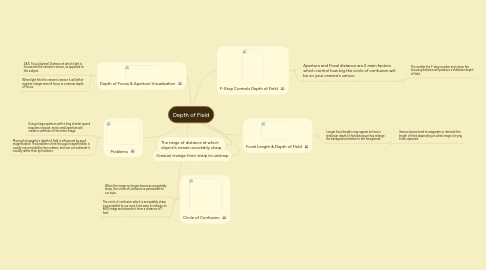Depth of Field
por Alyssa Sialaris


1. Gradual change from sharp to unsharp
2. The range of distance at which object/s remain accetably sharp.
3. Circle of Confusion
3.1. When the image no longer becomes acceptably sharp, the circle of confusion is perceptible to our eyes.
3.2. The circle of confusion which is acceptably sharp is perceptible to our eyes if we were to enlarge an 8x10 image and observe it from a distance of 1 foot.
4. Depth of Focus & Aperture Visualization
4.1. AKA: Focus Spread. Distance at which light is focused at the camera's sensor, as opposed to the subject.
4.2. When light hits the camera's sensor it will either register a larger area of focus or a narrow depth of focus.
5. Problems
5.1. Using a large aperture with a long shutter speed requirers a tripod, and a small aperture will create a softness of the entire image.
5.2. Macro photography's depth of field is influenced by pupil magnificaiton. The problem is that the pupil magnification is usually not provided by lens makers, and one can estimate it visually rather than by numbers.
6. F-Stop Controls Depth of Field
6.1. Aperture and Focal distance are 2 main factors which control how big the circle of confusion will be on your camera's sensor.
6.1.1. The smaller the F-stop number and closer the focusing distance will produce a shallower depth of field.
7. Focal Length & Depth of Field
7.1. Longer focal lengths may appear to have a shallower depth of field becasue they enlarge the background relative to the foreground.
7.1.1. Various lenses tend to exagerate or diminish the length of field depending on what image is trying to be captured.
